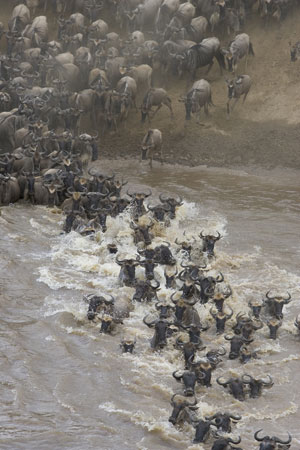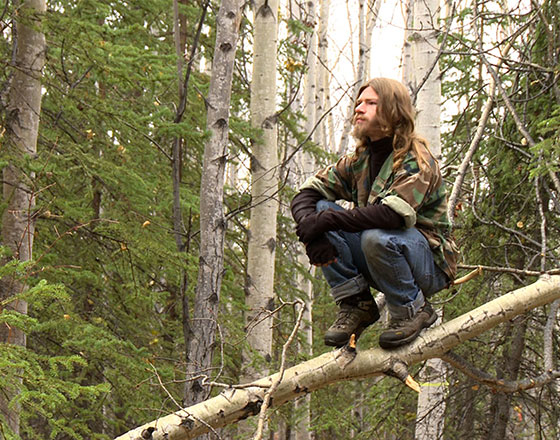By RabbitEars
Don’t forget this weekend to tune in to Discovery Channel‘s great new miniseries Nature’s Most Amazing Events. Discovery co-produced the series with the BBC, their production partners on Planet Earth. That series set the bar for natural history programming so high that I wasn’t sure if this new series woul d be quite as awe-inspiring. While Planet Earth remains on a level of its own, this series comes very close to it and is still the best nature show — or any show period — you’re likely to see this year. And it is unique in that each of its six episodes focuses on one particular event, in one location, in the natural world, where Planet Earth, as its title indicates, globe-trotted all across the world in each episode. The focus on individual events here lends a bit of intimacy to the epic landscapes as we get to meet particular creatures and how they respond to events ranging from floods and ice melts to huge salmon runs and migrations.
d be quite as awe-inspiring. While Planet Earth remains on a level of its own, this series comes very close to it and is still the best nature show — or any show period — you’re likely to see this year. And it is unique in that each of its six episodes focuses on one particular event, in one location, in the natural world, where Planet Earth, as its title indicates, globe-trotted all across the world in each episode. The focus on individual events here lends a bit of intimacy to the epic landscapes as we get to meet particular creatures and how they respond to events ranging from floods and ice melts to huge salmon runs and migrations.
I also went in to watching the series with a question of just how many new things it would be able to show us. After all, Planet Earth broke so much new ground in terms of its technological achievements, as well as in filming rarely seen animals and locales — often for the first time — that it seems like it would be hard to duplicate such surprises. But in a testament to the planet’s incredible wildlife diversity, and to the intrepid filmmakers, we do see plenty of cool new stuff, such as extensive aerial footage of the Arctic-dwelling narwhal — a strange whale with a long, unicorn-like tusk that you may have only heard of before if you had listened carefully to the song “Rock Lobster.”
Among the other television firsts in Nature’s Most Amazing Events:
* Footage of Cape fur seals coming ashore to snatch gannet chicks from their colony
* The eruption of the Ol Doinyo Lengal Volcano in the Serengeti — the first eruption since 1967 — filmed in HD from the ground and air
* Pack of wolves attacking an adult grizzly bear in Canada
* Underwater footage of bears catching salmon with their feet, filmed by producer Jeff Turner, who swam with the bears
* Film of the Okavango Delta flood at every level, from macro to aerial photography
* Elephants using their trunks to siphon water from the top of dirty pools
* Killer whales attacking and killing a huge male sea lion
* Shoal of sardines 15 miles long, surrounded by thousands of sharks; 10,000 gannets raining down on a shoal of fish and a super-pod of 5,000 common dolphins, all filmed using a high-definition helicopter mount
* Bubble netting by humpback whales films from the air and on the surface, together with incredible sound to illustrate the cooperative fishing behavior of these whales
The events featured in each episode include the following. Check ’em out:
Arctic Summer — May 29, 8pm ET/PT. During an Arctic summer, nearly three million square miles of sea ice rapidly begin to melt. For polar bears, the change in habitat threatens their survival. For other, like Arctic foxes, whales and flocks of birds, this brief summer transforms the Arctic into one of the richest and most dramatic places on Earth. Cameras in this episode captured the greatest seasonal change on the planet during a year when the sea ice retreated further and quicker than ever before.
Grizzly Wilderness — May 29, 9pm ET/PT. The annual return of Pacific salmon to the rivers where they were born is one of the greatest natural events in the world. Each year, more than 500 million salmon swing up to 20,000 miles to return to their birthplace to spawn and die. This episode follows the fierce competition among bears and wolves as they hunt the salmon. A specially designed underwater camera kit also records how the salmon swim upstream against powerful torrents while trying to avoid the predators.
Surviving the Serengeti — May 30, 8pm ET/PT. Each year, more than a million wildebeest and a quarter million zebra and gazelle migrate on Tanzania’s Serengeti Plains in an epic trek that follows the rains to fresh pastures. But this migration also leaves behind desperate predators that must struggle to survive.
Army of Predators — May 30, 9pm ET/PT. As winter arrives along South Africa’s east coast, the inshore waters cool and draw nearly a billion sardines northwards. This 15-mile-long sardine run rings the dinner bell for the planet’s g reatest concentration of predators, including dolphins, sharks, whales and birds, with massive feeding frenzies ensuing.
reatest concentration of predators, including dolphins, sharks, whales and birds, with massive feeding frenzies ensuing.
Kalahari Flood — May 31, 8pm ET/PT. At the peak of the dry season in the Kalahari Desert, herds of elephants reveal remarkable new behavior as they make the most of stagnant pools, arid woodlands and dwindling waterholes guarded by lions. Their fortunes change, though, with the dramatic annual flooding of Botswana’s Okavango Delta, which turns 4,000 square miles of desert into an incredible maze of lagoons, islands and swamps. Elephants, buffalo, bull hippos, swamp deer, zebra, giraffe, crocodiles and numerous birds and fish invade the wetlands, setting up some of the greatest clashes in nature.
Pacific Feast — May 31, 9pm ET/PT. In the northeast Pacific, along the coasts of Alaska and British Columbia, the arrival of summer triggers an explosion of plant life greater in scale than the Amazon rainforest. The basis of this bloom is plankton — microscopic floating plants. The plankton attracts enormous amounts of wildlife — herring, whales, sea lions, birds — all of whom race to make the most of the abundant feeding season.
__________________________________
Sea Lion — Credit: Jon Bryan/Discovery Channel/BBC
Wildebeest — Credit: Suzi Ezterhas/naturepl.com/Discovery Channel/BBC



